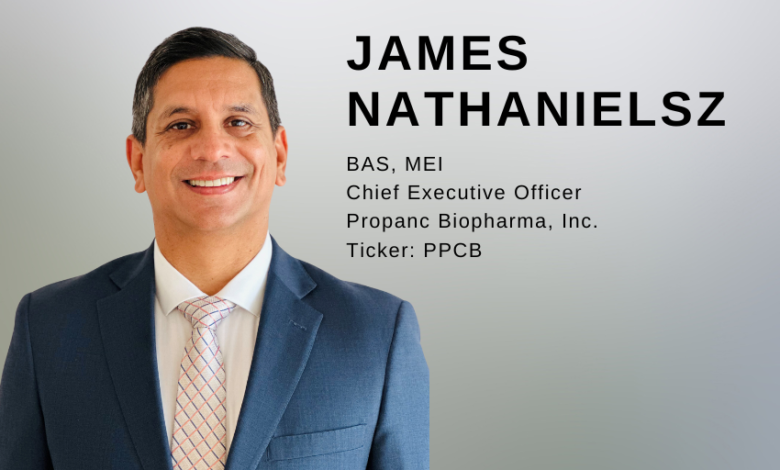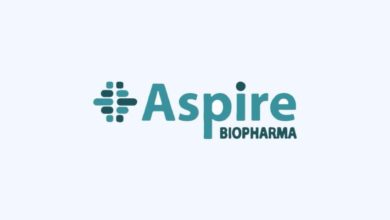SmallCaps Daily Sits Down with James Nathanielsz, CEO of Propanc Biopharma, Inc.

James Nathanielsz – CEO, Executive Chairman and CFO
James Nathanielsz has served as a director and Chief Executive Officer of Propanc Biopharma since October 2007. From July 2006 until October 2007, Mr. Nathanielsz served as the New Products Manager of Biota Holdings Limited, an anti-infective drug development company in Australia. Mr. Nathanielsz was selected as a director because he is the Co-Founder of Propanc and for his experience in R&D and manufacturing and distribution.
Mr. Nathanielsz holds a B.App.Sci in Biochemistry/Applied Chemistry and an M.E.I. from Swinburne University of Technology in Melbourne, Australia.

Full Interview:
Thank you for taking the time to answer my questions about Propanc Biopharma, Inc. (OTC Pink: PPCB) For our readers who may be unfamiliar, will you briefly describe the Company and its focus?
Firstly, my pleasure. Our focus is to develop a long-term therapy for the treatment and prevention of metastatic cancer for patients suffering from solid tumors for global distribution. Metastatic cancer from solid tumors remains the single biggest cause of death for sufferers.
Propanc Biopharma has a strong pipeline with over 60 products in clinical development. Can you provide insights into the key products and their potential impact on the cancer treatment landscape?
Propanc Biopharma has two key products in development based on a novel approach using a pancreatic proenzyme therapy to treat and prevent metastatic cancer from solid tumors. Metastatic cancer remains the main cause of patient death for sufferers. The Company’s lead product candidate, PRP, consists of two proenzymes, chymotrypsinogen and trypsinogen that target and eradicate cancer stem cells that are resistant to standard treatments causing the patient to relapse, but also leaves healthy cells alone, making it free from severe, or even serious side effects.
PRP has the potential to treat most common solid tumors that develop chemoresistance and therefore become a welcome addition to the treatment process where standard treatment options are no longer available. The breadth of solid tumors, over 80% of all cancers originate from solid tumors, and the potential clinical applications that is complementary to existing treatment options suggests that PRP has the potential to become a novel, first in class treatment, with significant market potential for most patients suffering from advanced cancer from solid tumors.
How does PRP address unmet needs in the cancer treatment landscape? And what are the potential competitive advantages of PRP over existing treatment options?
PRP addresses the unmet need for a targeted therapy that successfully eradicates cancer stem cells, but leave healthy cells alone, which means there are no severe, or even serious side effects from treatment; no hair loss, no nausea, no immunosuppression. Patients are unlikely to need to be admitted as an inpatient for administration of the treatment. Existing treatment options which target cancer stem cells can often lead to tumor resistance, since they often target a specific pathway which can alter, rendering the treatment ineffective. PRP forces the cancer stem cell to express different proteins, which alters the characteristics of the cell, rendering it benign. Therefore, rather than directly targeting and killing cancer stem cells, PRP induces cell differentiation so they die off naturally! Chemoresistance is a significant issue among patients, and therefore a treatment which can address patient relapse, enabling them to undergo further treatment with current standard therapies has the potential to change the way we view cancer from a life ending disease to a chronic illness!
The recent announcement of entering a Phase Ib, First-In-Human study is a significant milestone. What are the key objectives of this study, and what outcomes does Propanc Biopharma hope to achieve?
Propanc will undertake a 30 – 40 patient study for advanced cancer patients suffering from solid tumors. The key objectives of this study are to define the maximum tolerated dose (MTD) by safely escalating the dosage in each 10-patient cohort, define the safety and tolerability to PRP among these patient groups, and finally, determine secondary efficacy endpoints according to a combination of the RECIST (Response evaluation criteria in solid tumors) and irRC (Immune-related Response Criteria). RECIST is a standard approach to measuring efficacy endpoints, whereas irRC defines when tumors in cancer patients improve ("respond"), stay the same ("stabilize"), or worsen ("progress") during treatment, where the compound being evaluated is an immuno-oncology drug. PRP has been confirmed scientifically to not only specifically target cancer cells from solid tumors, but also alters the micro-immune environment of the tumors, which is why we plan to look at a combination of both criteria. However, since this is a Phase Ib study, our immediate goals are to define the MTD and elucidate the safety profile of PRP prior to entering two, Phase IIa, 60 patient, proof of concept studies in pancreatic and ovarian cancers.
The compassionate patient treatment results indicate positive outcomes with no adverse events. Can you share any specific patient success stories or outcomes that showcase the potential impact of PRP on improving patients' lives?
The compassionate patient treatment results underwent a retrospective review after receiving treatment from a proenzyme treatment supplied and administered by my colleague, Cofounder and Chief Scientific Officer, Dr Julian Kenyon, a suppository formulation consisting of two pancreatic proenzymes trypsinogen and chymotrypsinogen. Overall, 19 from 46 patients (41.3%) with advanced malignant diseases, most of them suffering from metastases, had a survival time significantly longer than the expected life span, in fact, for the whole set of cancer types, mean survival (9.0 months) was significantly higher than mean life expectation (5.6 months). Although the number of patients per cancer indication is naturally quite low, 3 out of 8 patients with prostate cancer and 5 out of 11 patients with gastrointestinal cancers appear to particularly benefit from the treatment with the proenzyme suppositories.
Given these patients were suffering from advanced cancer from solid tumors, and already metastatic, there were some meaningful observations after receiving treatment:
- A pancreatic cancer patient who quadrupled their life expectancy from a 2-month life expectancy survived 8 months;
- An ovarian cancer patient with less than a 12-month life expectancy survived 38 months;
- A colorectal cancer patient with a 6-month life expectancy survived 40 months; and
- A patient with a metastatic neuroendocrine tumor with a 10-month life expectancy survived 24 months.
The colorectal and neuroendocrine cancer patients both felt well enough later on to receive a further round of chemotherapy. Although Dr Kenyon can best testify to the individual patient case narratives, a 40yo ovarian cancer patient, which encouraged Dr Kenyon to search for a therapy that could meaningfully and compassionately extend her life, inspired the formation of our company. The patient had an urarchal tumour which is essentially an embryonal bladder tumour. She also had an ovarian cancer. All of this was treated in 2000 with a partial cystectomy. In June 2007 she was found to have a recurrence of her cancer, and the disease had spread to the sacrum, and throughout the pelvis. She was offered chemotherapy, which she had, but there was no result from this. Her median survival in June 2007 was 3 months. She commenced the pancreatic proenzymes suppository treatment mid-September 2007. She continued treatment up until her death in August 2008. She was an example of a case in which no other existing treatment could offer any hope. According to Dr Kenyon, the proenzyme therapy did give her extended median survival. She is survived by her husband and son.
With a growing IP of 76 patents, how does the company plan to manage its intellectual property to maximize shareholder value?
We expect to continue to expand and grow our intellectual property portfolio as we continue to advance PRP and our preclinical candidate, rec-PRP, a synthetic recombinant version of our lead product candidate, further along the development pathway. This includes composition patents, method of use patents, and additional claims as we refine the manufacture, dosage and administration of each candidate in development. This will enable us to essentially capture a market where virtually no known competitor intellectual property claims exist using our technology in the field of cancer.
With the potential market for PRP in pancreatic cancer estimated at $6.93 billion by 2030, how does Propanc Biopharma intend to position itself to capture a significant share of this market? And how will the company leverage the benefits of Orphan Drug Designation, including FDA-administered market exclusivity, tax credits, and R&D grants, to achieve this goal?
We anticipate positioning ourselves in the market as an addition to the treatment process that is complementary to existing treatment options. Given the favorable safety profile of our drug, we expect PRP to move to a frontline treatment option very quickly. Therefore, although not yet perfected in certain cancers, we will look to capture patients at a much earlier stage of the disease process, such as high-risk patients, identified via genetic screening. Furthermore, we have already investigated chemoresistant human pancreatic cancer cell lines to the current standard of treatment, gemcitabine™ in the laboratory, which could allow for potential further clinical applications which we plan to investigate in future combination studies in the clinic.
Regarding achieving Orphan Drug Designation status from the FDA, this means we can receive 7 years market exclusivity in our selected target patient population post drug approval. This is a very attractive proposition to potential licensing partners, and therefore we can consider approaching potential suitors in early-stage clinical development, such as Phase I, since we have already achieved this status which is normally designated to clinical stage companies. However, since we already had supportive clinical data from compassionate use, we were able to apply much earlier in the process.
What challenges is PPCB facing, if any, and how is the Company addressing these challenges?
As a pre-revenue development stage biotech company listed currently on the OTC Pink Market, we have continued to search for sufficient capital to rapidly progress PRP into the clinic. We’re addressing this challenge with a multi-pronged approach, utilizing existing financiers that invest in micro-cap companies like ours, but also widening our net to a range of financial investment vehicles that are more strategic, can see the untapped potential of our technology and understand that after more than 15 years of research and development with over $23 million invested, we’re ready to determine the potential of our drug in our target patient populations. Since we’re backed by a significant, 100-year history of our technology administered to humans, similar to the story of immunotherapy, we believe strongly that our technology works, and is safe and effective, the question remaining is, by how much?
In terms of the Company's long-term strategy and vision, what are Propanc Biopharma’s goals as you look forward?
Our goal is very simple. We’ve completed the research & development work necessary to get this into patients as soon as possible, and if it works, get it to as many patients as possible. Our strategy is to fast track our drug through to proof of concept, and if successfully established, seek fast track designation for approval if the results are strong enough. We will either look for a global licensing partner, or a distributor, depending on whether we can file an ANDA (a new drug application) for approval at that stage. We have already fielded interest from one of the top global oncology biomedical companies in the world, and a number have expressed a desire to review the initial patient data as we progress into the clinic, which will be after 3 months into our Phase Ib, First-In-Human study in advanced cancer patients suffering from solid tumors.
Propanc Biopharma has raised $23M since its inception. How does the company plan to utilize this capital, especially in the context of the upcoming Phase Ib study, and what financial milestones should investors be aware of in the coming year?
By undertaking our first clinical study next year, we hope to have a strong enough balance sheet to evaluate the requirements for an up-listing to a US national stock exchange, like NASDAQ, since our company was audited from inception, never a shell and fully reporting. Furthermore, we will present our initial 3-month clinical results from our first study to potential licensing partners who have expressed interested in our program. If the interest is strong enough with a potential partner that shares our vision for the widespread potential of this treatment, we will look to execute a licensing deal.
Additionally, the two raw material ingredients that form PRP are sourced from a supplier whom we plan to work with to become GMP (Good Manufacturing Practice) accredited prior to entering Phase II development, in exchange for either an equity, or a profit share arrangement for the active ingredients of our drug. This means we can further enhance our position along the value chain, by also capitalizing on the sourcing of the raw materials once licensed. Our long-term goal will consider vertical integration as a manufacturer. Since the supply of this drug is naturally derived and extracted from bovine sources, it is cost effective and readily available compared to other treatments, which could become a realistic therapeutic option for global use, thus capturing our vision of creating life changing healthcare for patients all over the world.
Is there any other information you wish to share with our investors reading so we can highlight the opportunity of PPCB?
Everyone is affected by cancer. Rather than a technology looking for an application in a selected market, we chose our technology because of the scientific burden of proof this treatment works and our motivation to help people suffering from this terrible disease, someone’s mother, father, son, or daughter. The development of our intellectual property, investigating how the technology works, optimizing the performance and stability of this biological formulation for potential commercial application has been challenging and tremendously complexed, but after 15 years, we believe we have something truly extraordinary that can meaningfully extend the lives of many sufferers. We look forward to putting this to the test in our future clinical studies. Thank you.
Thank you for your time.



